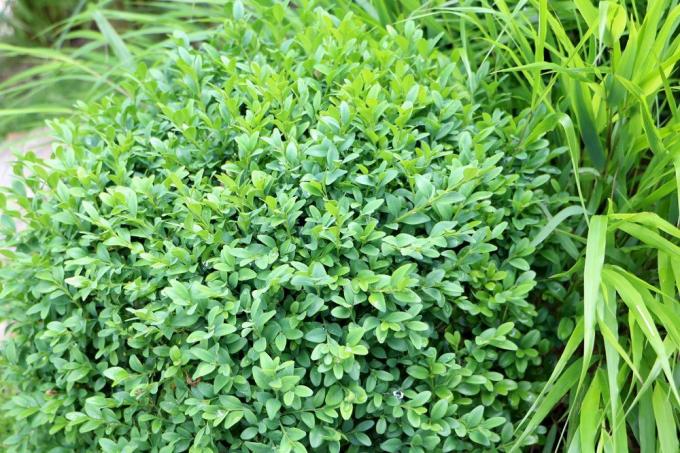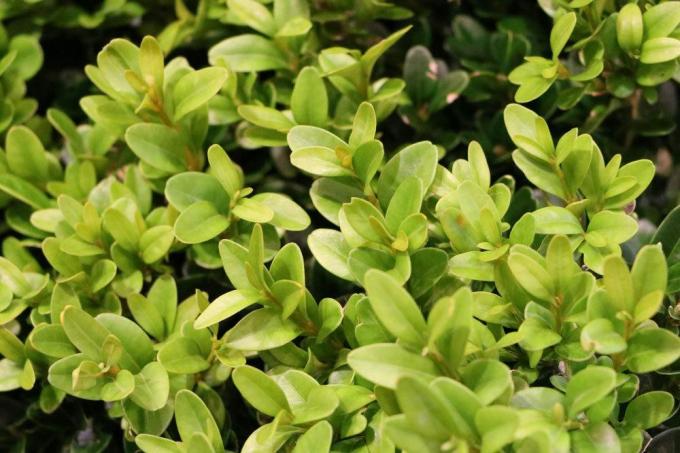
table of contents
- care
- to water
- Fertilize
- Location
- Root protection
- protection
- Winter in the house
- Hardening
- Winter hardy varieties
Hibernating a box tree in a bucket should actually be very easy, after all, the evergreen plants are robust and resilient. However, many box trees do not survive - even though they do not freeze to death. Instead, the plants often dry up. However, with proper preparation and care, this problem can be prevented.
care
If the boxwood is in the bucket, the effort for cultivation generally differs from the maintenance in the field. This is simply due to the fact that the roots have less space and also less nutrients and moisture from the soil. In winter, therefore, you must also pay attention to some factors that play a special role in bucket culture.
- Isolation of the roots
- sheltered location
- Sun protection for the leaves
- preparatory fertilization
- Getting used to the field
- Watering when dry
to water
The most important and at the same time most difficult thing for the wintering of the boxwood in the bucket is the water supply. As mentioned at the beginning, many of the plants do not freeze to death, but rather dry up. Evaporation through the leaves continues and the roots also grow, while the substrate in the planter only offers a very limited supply of moisture.

In addition, the fluid intake is limited or not possible at all in freezing temperatures. Therefore, care must be taken that the substrate does not dry out. On frost-free days you have to water, but little and as often as possible. Regular checks are important for the health of the crops.
Fertilize
Preparatory fertilization
Potassium fertilizers should be used in late August and September. This promotes the lignification of the boxwood shoots and thus prevents frostbite and damage caused by drought. The plant is protected from the inside out and prepared for winter.
Location
A comparatively warm, sheltered location is ideal for wintering the boxwood in the bucket. It should be bright but not in the blazing sun. A sheltered and slightly shady corner on the balcony facing south or east would be ideal. If these conditions cannot be implemented, the appropriate protection can help.
Root protection
Even if the box is generally frost-hardy plants, they still need appropriate protection in the container culture. There are various ways of proceeding here.
Outdoors
It is possible to plant the entire bucket outdoors. The roots are thus directly protected from frost by the surrounding substrate. The bucket can be dug up again in spring. This variant is recommended for larger specimens and those plants that are outdoors all year round and have already gotten some frost every now and then - because these are already hardened.
In a double bucket
The planter is placed in a larger container, with both containers placed on ledges, a pallet or styrofoam to create a distance from the ground. The space between the two buckets is filled with bark mulch, straw or bubble wrap and the larger bucket is wrapped again on the outside.

Put on a pedestal
An upturned bucket, wooden blocks, pallet or similar is used as a spacer to the floor. The bucket is in turn isolated from the outside by wrapping it thickly with garden fleece, styrofoam or bubble wrap.
Tip: When wrapping, it should be ensured that there is still access to the substrate. This is important for the necessary watering.
protection
Wind protection and sun protection
Wind has a drying effect on the leaves as it promotes evaporation. The same applies to excessive solar radiation. The possible consequence is dried out and burnt leaves. In addition, growth is stimulated, which makes the box tree more vulnerable in winter.
The leaves therefore need protection from wind and sun. Shading nets that are thrown over the leaves on particularly windy and sunny days are ideal. These are also beneficial for box trees that have been planted outdoors. Alternatively, parasols and sails or coconut mats can also be used.

Winter in the house
The easiest way to overwinter the boxwood in the bucket is to bring it into the house. Here it should stand frost-free and light. Fertilization is not necessary. However, watering must still be done because it is an evergreen plant. This means that moisture continues to evaporate through the leaves. In addition, the roots grow primarily in winter. It is ideal if the substrate is always kept slightly moist and does not dry out. But it shouldn't be wet either.
Tip: Smaller and young box trees in particular should be overwintered indoors in any case. This also applies to varieties that are not completely hardy in our latitudes.
Hardening
Hardening of the boxwood
If the boxwood is to be overwintered in the bucket, it must be used to it as early as possible. It should therefore be outdoors from spring onwards. If it has an optimal location and is well cared for, it can easily survive one or the other late frost. This is exactly what is important so that the plant is hardened and can later be overwintered in the bucket.
If the box tree does not get outside until later in the gardening season, it should urgently be overwintered in the house when cultivating in the tub. Otherwise the risk of frostbite and damage caused by drought is very high.
Winter hardy varieties
If the boxwood is to be able to safely overwinter outdoors in the bucket, the choice of the variety is crucial.

Well hardy varieties include:
- Blue Heinz
- Dee Runk
- Handsworthiensis
- Mansion
- Highlander
- Monrue
- Rotundifolia
- Suffruticosa
In general, however, all box trees are sufficiently hardy to survive frosty times in our latitudes. The green specimens, however, are usually a little more than colorful variants.



